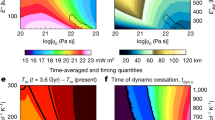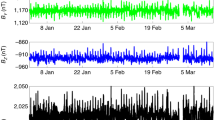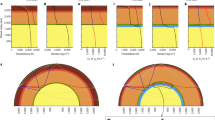Abstract
Knowledge of the interior structure and atmosphere of Mars is essential to understanding how the planet has formed and evolved. A major obstacle to investigations of planetary interiors, however, is that they are not directly accessible. Most of the geophysical data provide global information that cannot be separated into contributions from the core, the mantle and the crust. The NASA InSight mission changed this situation by providing high-quality seismic and lander radio science data1,2. Here we use the InSight’s radio science data to determine fundamental properties of the core, mantle and atmosphere of Mars. By precisely measuring the rotation of the planet, we detected a resonance with a normal mode that allowed us to characterize the core and mantle separately. For an entirely solid mantle, we found that the liquid core has a radius of 1,835 ± 55 km and a mean density of 5,955–6,290 kg m−3, and that the increase in density at the core–mantle boundary is 1,690–2,110 kg m−3. Our analysis of InSight’s radio tracking data argues against the existence of a solid inner core and reveals the shape of the core, indicating that there are internal mass anomalies deep within the mantle. We also find evidence of a slow acceleration in the Martian rotation rate, which could be the result of a long-term trend either in the internal dynamics of Mars or in its atmosphere and ice caps.
This is a preview of subscription content, access via your institution
Access options
Access Nature and 54 other Nature Portfolio journals
Get Nature+, our best-value online-access subscription
$29.99 / 30 days
cancel any time
Subscribe to this journal
Receive 51 print issues and online access
$199.00 per year
only $3.90 per issue
Buy this article
- Purchase on Springer Link
- Instant access to full article PDF
Prices may be subject to local taxes which are calculated during checkout




Similar content being viewed by others
Data availability
The RISE data that support the findings of this study are available on the Planetary Data system: https://pds-geosciences.wustl.edu/missions/insight/rise.htm. Doppler data for Viking are in the REDUCED directories: https://pds-geosciences.wustl.edu/missions/mpf/radioscience.html. DSN media calibration files are given in the RISE PDS archives: https://pds-geosciences.wustl.edu/insight/urn-nasa-pds-insight_rise_raw/data_tro/. The full correlation matrix is available as source data for Extended Data Fig. 3b. Source data are provided with this paper.
Code availability
Distribution of the MONTE navigation code is restricted by the Export Administration Regulations of the US Department of Commerce. Eligible readers may request a copy of MONTE, under a licence that does not permit redistribution, at https://montepy.jpl.nasa.gov/. GINS software is the property of CNES. It can be used for research only; any other commercial or non-commercial uses are strictly prohibited. CNES grants to the GINS Licensee (natural person) a free non-exclusive licence.
References
Banerdt, W. B. et al. Initial results from the InSight mission on Mars. Nat. Geosci. 13, 183–189 (2020).
Folkner, W. M. et al. The rotation and interior structure experiment on the InSight mission to Mars. Space Sci. Rev. 214, 100 (2018).
Dehant, V. & Mathews, P. M. Precession, Nutation and Wobble of the Earth (Cambridge Univ. Press, 2015).
Sasao, T., Okubo, S. & Saito, M. A simple theory on dynamical effects of stratified fluid core upon nutational motion of the Earth. Proc. IAU Symp. 78, 165–183 (1980).
Folkner, W. M. et al. Interior structure and seasonal mass redistribution of Mars from radio tracking of Mars Pathfinder. Science 278, 1749–1752 (1997).
Yoder, C. F. & Standish, E. M. Martian precession and rotation from Viking lander range data. J. Geophys. Res. 102, 4065–4080 (1997).
Evans, S. et al. MONTE: the next generation of mission design and navigation software. CEAS Space J. 10, 79–86 (2018).
Marty, J. C. et al. GINS: the CNES/GRGS GNSS scientific software. 3rd Int. Coll. Sci. Fundam. Asp. Galileo Program. ESA Proc. WPP326 31, 8–10 (2011).
Le Maistre, S. et al. Lander radio science experiment with a direct link between Mars and the Earth. Planet. Space Sci. 68, 105–122 (2012).
Konopliv, A. S. et al. Detection of the Chandler wobble of Mars from orbiting spacecraft. Geophys. Res. Lett. 47, e2020GL090568 (2020).
Baland, R.-M. et al. The precession and nutations of a rigid Mars. Celest. Mech. Dyn. Astron. 132, 47 (2020).
Banfield, D. et al. InSight Auxiliary Payload Sensor Suite (APSS). Space Sci. Rev. 215, 4 (2019).
Sanloup, C. et al. Density measurements of liquid Fe–S alloys at high-pressure. Geophys. Res. Lett. 27, 811–814 (1999).
Yoshizaki, T. & McDonough, W. F. The composition of Mars. Geochim. Cosmochim. Acta 273, 137–162 (2020).
Smrekar, S. E. et al. Pre-mission InSights on the interior of Mars. Space Sci. Rev. 215, 3 (2019).
Yoder, C. F., Konopliv, A. S., Yuan, D. N., Standish, E. M. & Folkner, W. M. Fluid core size of Mars from detection of the solar tide. Science 300, 299–303 (2003).
Stähler, S. C. et al. Seismic detection of the martian core. Science 373, 443–448 (2021).
Rivoldini, A., Van Hoolst, T., Verhoeven, O., Mocquet, A. & Dehant, V Geodesy constraints on the interior structure and composition of Mars. Icarus 213, 451–472 (2011).
Khan, A. et al. A geophysical perspective on the bulk composition of Mars. J. Geophys. Res. 123, 575–611 (2018).
Wieczorek, M. A., Beuthe, M., Rivoldini, A. & Van Hoolst, T. Hydrostatic interfaces in bodies with nonhydrostatic lithospheres. J. Geophys. Res. Planets 124, 1410–1432 (2019).
Kiefer, W. S., Bills, B. G. & Nerem, R. S. An inversion of gravity and topography for mantle and crustal structure on Mars. J. Geophys. Res. Planets 101, 9239–9252 (1996).
Defraigne, P., Dehant, V. & Van Hoolst, T. Steady-state convection in Mars’ mantle. Planet. Space Sci. 49, 501–509 (2001).
Samuel, H. et al. The thermo-chemical evolution of Mars with a strongly stratified mantle. J. Geophys. Res. Planets 126, e2020JE006613 (2021).
McNamara, A. K. A review of large low shear velocity provinces and ultra low velocity zones. Tectonophysics 760, 199–220 (2019).
Steenstra, E. S. & van Westrenen, W. A synthesis of geochemical constraints on the inventory of light elements in the core of Mars. Icarus 315, 69–78 (2018).
Gendre, H., Badro, J., Wehr, N. & Borensztajn, S. Martian core composition from experimental high-pressure metal-silicate phase equilibria. Geochem. Perspect. Lett. 21, 42–46 (2022).
Shibazaki, Y. et al. Hydrogen partitioning between iron and ringwoodite: implications for water transport into the Martian core. Earth Planet. Sci. Lett. 287, 463–470 (2009).
Zharkov, V. N. The internal structure of Mars: a key to understanding the origin of terrestrial planets. Sol. Syst. Res. 30, 456–465 (1996).
Tsuno, K., Frost, D. J. & Rubie, D. C. The effects of nickel and sulphur on the core–mantle partitioning of oxygen in Earth and Mars. Phys. Earth Planet. Inter. 185, 1–12 (2011).
Defraigne, P., Rivoldini, A., Van Hoolst, T. & Dehant, V. Mars nutation resonance due to free inner core nutation. J. Geophys. Res. Planets 108, 5128 (2003).
Mittelholz, A. et al. Timing of the martian dynamo: new constraints for a core field 4.5 and 3.7 Ga ago. Sci. Adv. 6, eaba0513 (2020).
Lodders, K. Relative atomic Solar System abundances, mass fractions, and atomic masses of the elements and their isotopes, composition of the solar photosphere, and compositions of the major chondritic meteorite groups. Space Sci. Rev. 217, 44 (2021).
Estefan, J. A. & Sovers, O. J. A Comparative Survey of Current and Proposed Tropospheric Refraction-Delay Models for DSN Radio Metric Data Calibration. JPL Publication 94-24 (NASA 1994).
Le Maistre, S. Martian lander radio science data calibration for Mars troposphere. Radio Sci. 55, e2020RS007155 (2020).
Buccino, D., Border, J. S., Folkner, W. M., Kahan, K. & Le Maistre, S. Low-SNR Doppler data processing for the InSight radio science experiment. Remote Sens. 14, 1924 (2022).
Le Maistre, S., Rosenblatt, P., Dehant, V., Marty, J.-C. & Yseboodt, M. Mars rotation determination from a moving rover using Doppler tracking data: what could be done? Planet. Space Sci. 159, 17–27 (2018).
Folkner, W. M., Williams, J. G., Boggs, D. H., Park, R. S. & Kuchynka, P. The planetary and lunar ephemerides DE430 and DE431. IPN Progr. Rep. 42, 196 (2014).
Jacobson, R. A. & Lainey, V. Martian satellite orbits and ephemerides. Planet. Space Sci. 102, 35–44 (2014).
Dehant, V., Defraigne, P. & Van Hoolst, T. Computation of Mars’ transfer functions for nutations, tides and surface loading. Phys. Earth Planet. Inter. 117, 385–395 (2000).
Van Hoolst, T., Dehant, V., Roosbeek, F. & Lognonné, P. Tidally induced surface displacements, external potential variations, and gravity variations on Mars. Icarus 161, 281–296 (2003).
Archinal, B. A. et al. Report of the IAU Working Group on Cartographic Coordinates and Rotational Elements: 2015. Celest. Mech. Dyn. Astron. 130, 22 (2018).
Konopliv, A. S., Yoder, C. F., Standish, E. M., Yuan, D.-N. & Sjogren, W. L. A global solution for the Mars static and seasonal gravity, Mars orientation, Phobos and Deimos masses, and Mars ephemeris. Icarus 182, 23–50 (2006).
Dehant, V. et al. The radioscience LaRa instrument onboard ExoMars 2020 to investigate the rotation and interior of Mars. Planet. Space Sci. 180, 104776 (2020).
Kahan, D. S. et al. Mars precession rate determined from radiometric tracking of the InSight lander. Planet. Space Sci. 199, 105208 (2021).
Baland, R.-M., Hees, A., Yseboodt, M., Bourgoin, A. & Le Maistre, S. Relativistic contributions to the rotation of Mars. Astron. Astrophys. 670, A29 (2023).
Lange, L. et al. InSight pressure data recalibration, and its application to the study of long-term pressure changes on Mars. J. Geophys. Res. Planets 127, e2022JE007190 (2022).
de la Torre Juarez, M., Piqueux, S., Kass, D. M., Newman, C. & Guzewich, S. D. Pressure deficit in Gale crater and a larger northern polar cap after the Mars year 34 global dust storm. AGU Fall Meeting Abstr. P51C-02 (2019).
Kuchynka, P. et al. New constraints on Mars rotation determined from radiometric tracking of the Opportunity Mars Exploration Rover. Icarus 229, 340–347 (2014).
Panning, M. P. et al. Planned products of the Mars structure service for the InSight mission to Mars. Space Sci. Rev. 211, 611–650 (2017).
Connolly, J. A. D. Computation of phase equilibria by linear programming: a tool for geodynamic modeling and its application to subduction zone decarbonation. Earth Planet. Sci. Lett. 236, 524–541 (2005).
Stixrude, L. & Lithgow-Bertelloni, C. Thermodynamics of mantle minerals – I. Physical properties. Geophys. J. Int. 162, 610–632 (2005).
Greenwood, S., Davies, C. J. & Pommier, A. Influence of thermal stratification on the structure and evolution of the Martian core. Geophys. Res. Lett. 48, e2021GL095198 (2021).
Terasaki, H. et al. Pressure and composition effects on sound velocity and density of core-forming liquids: implication to core compositions of terrestrial planets. J. Geophys. Res. Planets 124, 2272–2293 (2019).
Tsuno, K., Grewal, D. S. & Dasgupta, R. Core–mantle fractionation of carbon in Earth and Mars: the effects of sulfur. Geochim. Cosmochim. Acta 238, 477–495 (2018).
Okuchi, T. Hydrogen partitioning into molten iron at high pressure: implications for Earth’s core. Science 278, 1781–1784 (1997).
Clesi, V. et al. Low hydrogen contents in the cores of terrestrial planets. Sci. Adv. 4, e1701876 (2018).
Malavergne, V. et al. Experimental constraints on the fate of H and C during planetary core–mantle differentiation. Implications for the Earth. Icarus 321, 473–485 (2019).
Yuan, L. & Steinle-Neumann, G. Strong sequestration of hydrogen into the Earth’s core during planetary differentiation. Geophys. Res. Lett. 47, e2020GL088303 (2020).
Anderson, D. L. & Minster, J. B. The frequency dependence of Q in the Earth and implications for mantle rheology and Chandler wobble. Geophys. J. R. Astron. Soc. 58, 431–440 (1979).
Yseboodt, M., Dehant, V. & Péters, M.-J. Signatures of the Martian rotation parameters in the Doppler and range observables. Planet. Space Sci. 144, 74–88 (2017).
Acknowledgements
This is InSight Contribution Number 211. The research done at the Royal Observatory of Belgium was supported by the Belgian PRODEX programme managed by the European Space Agency in collaboration with the Belgian Federal Science Policy Office, contract numbers PEA4000129361 and PEA4000140326. A.C. was supported by the French Community of Belgium within the frame of a FRIA grant. The work performed at the Jet Propulsion Laboratory, California Institute of Technology, was under contract with NASA. J.-C.M., D.A., J.B., M.D., H.S., M.W., P.L. acknowledge support from CNES and ANR (ANR-19-CE31-0008-08), and J.B., H.S. and P.L. thank IdEx Université de Paris (ANR-18-IDEX-0001). D.A. received funding from the European Research Council under the European Union’s Horizon 2020 research and innovation programme (grant agreement 724690). Those authors computing BSL models were given access to the HPC resources of IDRIS under the allocation A011041317 made by GENCI. J.B. acknowledges support from the European Research Council under the European Union’s Horizon 2020 research and innovation programme (grant agreement 101019965—ERC advanced grant SEPtiM).
Author information
Authors and Affiliations
Contributions
Writing the original draft: S.L.M., A.R., M.B., A.C., M.Y., R.-M.B., T.V.H., M.D. and H.S. Writing, review and editing: M.W. and D.A. Formal analysis: S.L.M. and A.C. Validation: D.B., A.K. and M.-J.P. Software: J.-C.M., S.L.M. and A.C. Data curation: D.K., D.B., S.L.M. and A.C. Methodology: A.R., M.Y., R.-M.B., M.B., T.V.H., D.A., J.B., M.D., A.-C.P., H.S. and N.T. Investigation: S.L.M., A.R., W.M.F., D.K. and D.B. Conceptualization: W.M.F., V.D. and P.L. Project administration: W.B.B., S.S. and M.P.
Corresponding author
Ethics declarations
Competing interests
The authors declare no competing interests.
Peer review
Peer review information
Nature thanks Michael Efroimsky and the other, anonymous, reviewer(s) for their contribution to the peer review of this work.
Additional information
Publisher’s note Springer Nature remains neutral with regard to jurisdictional claims in published maps and institutional affiliations.
Extended data figures and tables
Extended Data Fig. 1
RISE Doppler residuals and signature of the liquid core. Post-fit Doppler residuals and their histogram distributions for RISE (a) and Viking 1 lander (b) as a function of the mission time after landing and of the DSN facilities location. (c) Pre-fit Doppler residuals of RISE data as a function of time computed with the latest rotation models of Konopliv et al. (2020)10 (in blue) and Kahan et al. (2021)44 (in orange). (d) Pre-fit residuals with nominal values of the classical rotation model parameters coming from converged RISE solution using only the first 24 months of data (blue) and only the last 24 months of data (orange). This shows that the classical model fails at matching RISE full arc data since a clear trend is observed in the regions not covered by the corresponding nominal solution. (e) Theoretical signature of the liquid core for the RISE timing, separated in red for the East antenna and in green for the West antenna tracking. The FCN parameters are \(F=0.06\) and FCN period of −243 days. The orange envelope shows the signature when the FCN period is slightly different (between −238 and −248 days). The pink box is the interval where the SEP angle is smaller than 15° (conjunction) while the grey boxes are the intervals where the Earth declination is close to 0°. The signature of a parameter in the Doppler observable is the difference between the observable computed using a nominal/non-zero value for this parameter and that obtained when the parameter is set to 060.
Extended Data Fig. 2
RISE data calibrations. (a) Correction for media delays as applied to the RISE data points. On the left, the corrections due to the Earth’s atmosphere as a function of the elevation at the DSN, on the right those due to Mars’ troposphere, as a function of their elevation at Mars. (b) RISE Doppler residuals: only the red points are processed, i.e. used in our analysis. Points acquired at low elevation above the DSN station (orange diamonds) are affected by large noise from the Earth’s atmosphere. They are still part of our analysis thanks to our accurate Earth noise calibration. The rest of the points are eliminated due to low SEP (blue squares), or high residual value (green crosses). (c) Estimated wet troposphere bias parameter per pass, classified by DSN station identifier. Shaded area is the a priori uncertainty.
Extended Data Fig. 3 Mars rotation and orientation angles and their correlations.
(a) Reference frames and Mars orientation angles (orange and green) for conversion between the Earth mean equator of J2000 (in blue) and Mars body-fixed coordinates (in red). (b) Correlation matrix between MONTE solved parameters (GINS correlation matrix is equivalent) using the full set of RISE data (see Supplementary Table S1 for symbol definition). Values smaller than 0.3 are set to 0 for readability.
Extended Data Fig. 4 Comparison between the classical model of rotation of Mars and the one proposed in this study.
Temporal evolution of the 30-months solutions for the FCN period (a), the core amplification factor (b), and the precession rate (c), with the classical spin model (orange) and with the model with corrections on the rotation rate for the post-dust-storm period (blue). Shaded envelopes are \(1\sigma \) uncertainty bounds.
Supplementary information
Supplementary Information
This file contains sections 1–13, Supplementary Figs. 1–16, Supplementary Tables 1–5 and references.
Source data
Rights and permissions
Springer Nature or its licensor (e.g. a society or other partner) holds exclusive rights to this article under a publishing agreement with the author(s) or other rightsholder(s); author self-archiving of the accepted manuscript version of this article is solely governed by the terms of such publishing agreement and applicable law.
About this article
Cite this article
Le Maistre, S., Rivoldini, A., Caldiero, A. et al. Spin state and deep interior structure of Mars from InSight radio tracking. Nature 619, 733–737 (2023). https://doi.org/10.1038/s41586-023-06150-0
Received:
Accepted:
Published:
Issue Date:
DOI: https://doi.org/10.1038/s41586-023-06150-0
This article is cited by
-
PIONEERS: a 6DoF motion sensor to measure rotation and tides in the Solar System
Earth, Planets and Space (2024)
-
Evidence for a liquid silicate layer atop the Martian core
Nature (2023)
-
Geophysical evidence for an enriched molten silicate layer above Mars’s core
Nature (2023)
-
Mars orientation and rotation angles
Celestial Mechanics and Dynamical Astronomy (2023)
Comments
By submitting a comment you agree to abide by our Terms and Community Guidelines. If you find something abusive or that does not comply with our terms or guidelines please flag it as inappropriate.



